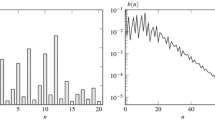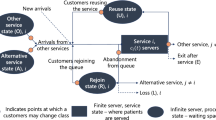Abstract
Most queueing models and their analysis have a rich history and follow a process of increased generality and complexity. In this paper, we introduce a new model, namely a multiclass queueing model where service times depend on the presence of one of the classes. Our model is motivated by road traffic, where the presence of heavy vehicles in a queue slows down the entire system, or, in contrast, where the presence of emergency vehicles may speed up the service. The specific assumption we impose is that the service time of each customer depends on whether at least one customer of that particular class is present in the system at the time of service. Although we study a fairly simple discrete-time model, we show that analysis is not straightforward. Furthermore, numerical examples expose that the impact of particular customers in the system can lead to a substantial slow down (or, in contrast, speed up) of the entire system.









Similar content being viewed by others
Notes
In between two instances where an arrival increases the system content from level i to level \(i+1\), there is exactly one departure that decreases the system content from level \(i+1\) to level i.
We observe the system just after a departure, i.e. excluding the customer that just departed.
This is a quite standard result which can be proved by Rouché’s theorem.
Other distributions can be chosen as well.
References
Adan I, Boxma O, Resing J (2022) Functional equations with multiple recursive terms. Queueing Syst 102:7–23
Alfa AS, Liu B, He QM (2003) Discrete-time analysis of MAP/PH/1 multiclass general preemptive priority queue. Naval Res Logist (NRL) 50(6):662–682
Bruneel H, Kim BG (1993) Discrete-time models for communication systems including ATM. Kluwer Academic Publishers, Boston
Daganzo CF (1994) The cell transmission model: a dynamic representation of highway traffic consistent with the hydrodynamic theory. Transp Res Part B Methodol 28(4):269–287
Daganzo CF (1995) The cell transmission model, part II: network traffic. Transp Res Part B Methodol 29(2):79–93
De Clercq S, Steyaert B, Bruneel H (2012) Delay analysis of a discrete-time multiclass slot-bound priority system. 4OR 10(1):67–79
De Clercq S, Laevens K, Steyaert B, Bruneel H (2013) A multi-class discrete-time queueing system under the FCFS service discipline. Ann Oper Res 202(1):59–73
De Muynck M, Bruneel H, Wittevrongel S (2020) Analysis of a queue with general service demands and correlated service capacities. Ann Oper Res 293(1):73–99
Gashaw S, Goatin P, Härri J (2018) Modeling and analysis of mixed flow of cars and powered two wheelers. Transp Res Part C Emerg Technol 89:148–167
Harrison PG, Zhang Y (2005) Delay analysis of priority queues with modulated traffic. In: 13th IEEE international symposium on modeling, analysis, and simulation of computer and telecommunication systems, Atlanta, 2005, pp 280–287. https://doi.org/10.1109/MASCOTS.2005.23
Hoogendoorn SP, Bovy PH (2000) Continuum modeling of multiclass traffic flow. Transp Res Part B Methodol 34(2):123–146
Kim B, Kim J (2020) Stability of a multi-class multi-server retrial queueing system with service times depending on classes and servers. Queueing Syst 94(1):129–146
Kim J, Ward AR (2013) Dynamic scheduling of a GI/GI/1+ GI queue with multiple customer classes. Queueing Syst 75(2):339–384
Kulkarni V, Glazebrook K (2002) Output analysis of a single-buffer multiclass queue: FCFS service. J Appl Probab 39:341–358
Lighthill MJ, Whitham GB (1955) On kinematic waves II. A theory of traffic flow on long crowded roads. Proc R Soc Lond Ser A Math Phys Sci 229(1178):317–345
Maertens T, Walraevens J, Bruneel H (2006) On priority queues with priority jumps. Perform Eval 63(12):1235–1252
Masuyama H, Takine T (2007) Multiclass Markovian fluid queues. Queueing Syst 56(3):143–155
Sleptchenko A, Selen J, Adan I, van Houtum GJ (2015) Joint queue length distribution of multi-class, single-server queues with preemptive priorities. Queueing Syst 81(4):379–395
Takine T (2001) Queue length distribution in a FIFO single-server queue with multiple arrival streams having different service time distributions. Queueing Syst 39(4):349–375
Tiaprasert K, Zhang Y, Aswakul C, Jiao J, Ye X (2017) Closed-form multiclass cell transmission model enhanced with overtaking, lane-changing, and first-in first-out properties. Transp Res Part C Emerg Technol 85:86–110
Tuerprasert K, Aswakul C (2010) Multiclass cell transmission model for heterogeneous mobility in general topology of road network. J Intell Transp Syst 14(2):68–82
Van Houdt B, Blondia C (2002) The delay distribution of a type k customer in a first-come-first-served MMAP [K]/PH[K]/1 queue. J Appl Probab 39:213–223
Walraevens J, Bruneel H, Fiems D, Wittevrongel S (2017) Delay analysis of multiclass queues with correlated train arrivals and a hybrid priority/FIFO scheduling discipline. Appl Math Model 45:823–839
Wittevrongel S, Feyaerts B, Bruneel H, De Vuyst S (2019) Delay characteristics in place-reservation queues with class-dependent service times. J Ind Manag Optim 15(1):37–58
Wong G, Wong S (2002) A multi-class traffic flow model an extension of LWR model with heterogeneous drivers. Transp Res Part A Policy Pract 36(9):827–841
Acknowledgements
This work was supported in part by an EOS grant from the Belgian Research Councils FWO and FNRS (Grant Number 30452698) and in part by a research project from the Flemish Research Council FWO (Grant Number 3G051118).
Author information
Authors and Affiliations
Corresponding author
Ethics declarations
Conflict of interest
Authors declare no conflict of interests.
Additional information
Publisher's Note
Springer Nature remains neutral with regard to jurisdictional claims in published maps and institutional affiliations.
Stability condition
Stability condition
In this Appendix, we discuss the stability condition for the case \(\alpha >0\). When \(\alpha =0\), the stability condition is that of a single-class system with only class-1 customers, i.e., \(\rho _1<1\).
First, recall that \((T_l,X_l)\), \(l\ge 1\) is a DTMC for which both coordinates can go to infinity. Secondly, the second component’s transitions depend on the state of the first component, see Sect. 3.2. The characterization of the stability region of such processes is known to be challenging because of these two observations. Therefore, in order to simplify the stability analysis, we modify the queueing system such that the corresponding DTMC is only unbounded in one coordinate.
Consider the following adapted queuing system which is identical to the original system w.r.t. the arrivals and the FCFS discipline, but where we now only have a type-2 service time if there is a class-2 customer in the first N customers present. To obtain the stability condition of this adapted queueing system, we assume that the system is saturated. This means that there are always enough customers present so that there are at least N customers waiting in the queue. Since the queueing system under consideration is work-conserving, the system reaches a stable regime if and only if the average amount of work—expressed in slots of service time—entering the system per slot is strictly less than one Bruneel and Kim (1993). Since an arriving customer is of class 2 with probability \(\alpha \), independent from customer to customer, and since we assume FCFS, the probability of having no class-2 customers in the first N waiting customers—and hence a type-1 service time—is given by \((1-\alpha )^N\). Hence, this leads to the following stability condition for the adapted queueing system:
From the equation above it is seen that the first term becomes negligible for large N and vanishes for \(N \rightarrow \infty \). Intuitively speaking, for \(\alpha >0\), this leads to the stability condition of the original queueing system: \(\rho _2<1\). When service times are assumed to be deterministic, we can make this more formal. The modified queueing system becomes either a dominant (\(\rho _1\ge \rho _2\) or equivalently \(S_1 \ge S_2\)) or a dominated (\(\rho _1 \le \rho _2\) or equivalently \(S_1 \le S_2\)) queueing system if the arrivals into both systems occur at exactly the same instants. For instance in the case that \(\rho _1\ge \rho _2\), the queue size in the adapted system will never be smaller than its counterpart in the original system, provided that the queues start with identical conditions in both systems. The dominance of the adapted system on the original system implies that the stability condition of the adapted system is a sufficient condition for the original system to be stable. Since this is true for every N, it follows that \(\rho _2<1\) is a sufficient condition for stability. To show that \(\rho _2<1\) is also a necessary condition, still assuming that \(\rho _1\ge \rho _2\), we can compare the original system with the system where every customer has a type-2 service time (see Sect. 4.1.2), which always has a better performance under the assumption that \(\rho _1\ge \rho _2\). Clearly, similar reasoning can be made for the case that \(\rho _1\le \rho _2\), which also lead to the stability condition \(\rho _2<1\). These arguments suggest that \(\rho _2 < 1\) is a natural condition for the stability of this system and the existence of a stationary distribution. However, we are at this point not able to prove the existence of the stationary distribution under \(\rho _2 < 1\). This remains for future work.
Rights and permissions
Springer Nature or its licensor (e.g. a society or other partner) holds exclusive rights to this article under a publishing agreement with the author(s) or other rightsholder(s); author self-archiving of the accepted manuscript version of this article is solely governed by the terms of such publishing agreement and applicable law.
About this article
Cite this article
Sasaninejad, S., Walraevens, J., Devos, A. et al. Analysis of a two-class queueing system with service times dependent on the presence of a certain class. Math Meth Oper Res 98, 351–376 (2023). https://doi.org/10.1007/s00186-023-00842-z
Received:
Revised:
Accepted:
Published:
Issue Date:
DOI: https://doi.org/10.1007/s00186-023-00842-z




